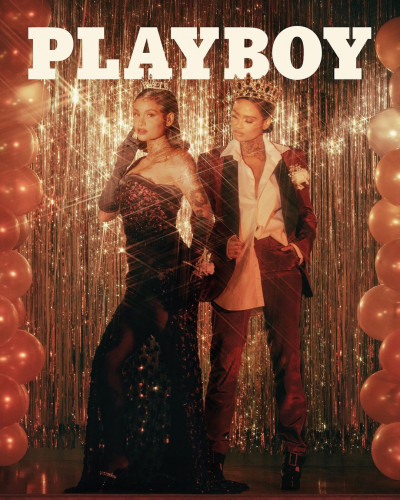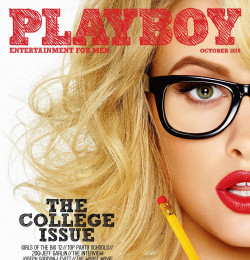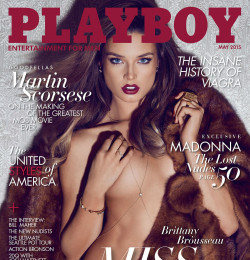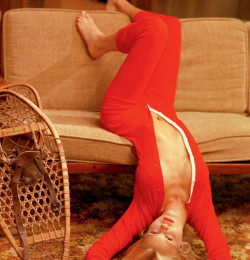Playboy USA


Playboy is an American men's magazine, founded in Chicago, Illinois in 1953, by Hugh Hefner and his associates, and funded in part by a $1,000 loan from Hefner's mother. The magazine has grown into Playboy Enterprises, Inc., with a presence in nearly every medium. Playboy is one of the world's best known brands. In addition to the flagship magazine in the United States, special nation-specific versions of Playboy are published worldwide.
The magazine has a long history of publishing short stories by notable novelists such as Arthur C. Clarke, Ian Fleming, Vladimir Nabokov, P. G. Wodehouse, and Margaret Atwood. Playboy features monthly interviews of notable public figures, such as artists, architects, economists, composers, conductors, film directors, journalists, novelists, playwrights, religious figures, politicians, athletes and race car drivers. The magazine throughout its history has expressed a libertarian outlook on political and social issues.
Playboy's original title was to be Stag Party, but an unrelated outdoor magazine, Stag, contacted Hefner and informed him that they would protect their trademark if he were to launch his magazine with that name. Hefner and co-founder and executive vice-president Eldon Sellers met to seek a new name. Sellers, whose mother had worked for the Chicago sales office of the short-lived Playboy Automobile Company, suggested "Playboy."
The first issue, in December 1953, was undated, as Hefner was unsure there would be a second. He produced it in his Hyde Park kitchen. The first centerfold was Marilyn Monroe, although the picture used originally was taken for a calendar rather than for Playboy. The first issue sold out in weeks. Known circulation was 53,991. The cover price was 50¢. Copies of the first issue in mint to near mint condition sold for over $5,000 in 2002. The novel Fahrenheit 451, by Ray Bradbury, was also serialized in the March, April, and May 1954 issues of Playboy magazine.
The logo, the stylized profile of a rabbit wearing a tuxedo bow tie, was designed by art designer Art Paul for the second issue and has appeared ever since. A running joke in the magazine involves hiding the logo somewhere in the cover art or photograph. Hefner said he chose the rabbit for its "humorous sexual connotation," and because the image was "frisky and playful."
An urban legend started about Hefner and the Playmate of the Month because of markings on the front covers of the magazine. From 1955 to 1979 (except for a six month gap in 1976), the "P" in Playboy had stars printed in or around the letter. The legend stated that this was either a rating that Hefner gave to the Playmate according to how attractive she was, the number of times that Hefner had slept with her, or how good she was in bed. The stars, between zero and twelve, actually indicated the domestic or international advertising region for that printing.
Since reaching its peak in the 1970s, Playboy has seen a decline in circulation and cultural relevance because of competition in the field it founded — first from Penthouse, Oui (which was published as a spin-off of Playboy) and Gallery in the 1970s; later from pornographic videos; and more recently from lad mags such as Maxim, FHM, and Stuff. In response, Playboy has attempted to re-assert its hold on the 18–35 male demographic through slight changes to content and focusing on issues and personalities more appropriate to its audience — such as hip-hop artists being featured in the "Playboy Interview".
Christie Hefner, daughter of the founder Hugh Hefner, joined Playboy in 1975 and became head of the company in 1988. She announced in December 2008 that she would be stepping down from leading the company, effective in January 2009, and said that the election of Barack Obama as the next President had inspired her to give more time to charitable work, and that the decision to step down was her own. “Just as this country is embracing change in the form of new leadership, I have decided that now is the time to make changes in my own life as well,” she said.
The magazine celebrated its 50th anniversary with the January 2004 issue. Celebrations were held at Las Vegas, Los Angeles, New York, and Moscow during the year to commemorate this event.
The magazine runs several annual features and ratings. One of the most popular is its annual ranking of the top "party schools" among all U.S. universities and colleges. For 2009, the magazine used five considerations: bikini, brains, campus, sex and sports in the development of its list. The top ranked party school by Playboy for 2009 was the University of Miami.
In June 2009, the magazine reduced its publication schedule to 11 issues per year, with a combined July/August issue and on 11 August 2009, London's Daily Telegraph newspaper reported that Hugh Hefner had sold his English Manor house (next door to the famous Playboy Mansion) for $18 m ($10 m less than the reported asking price) to a Daren Metropoulos and that due to significant losses in the company's value (down from $1billion in 2000 to $84mil in 2009) the Playboy publishing empire is up for sale for $300 m. In December 2009, they further reduced the publication schedule to 10 issues per year, with a combined January/February issue.





